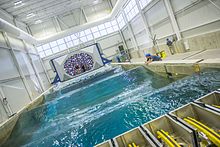Water channel

A water channel is a channel or a basin used to study currents . Similar to a wind tunnel , test objects are exposed to a controlled flowing medium. Due to the high density and low kinematic viscosity of water compared to air, high Reynolds numbers are achieved even at low flow velocities and small dimensions . With the same model size and flow velocity, the Reynolds number is around 15 times greater than in the wind tunnel. The disadvantage of cavitation can be reduced by increasing the water pressure .

With a wave channel are surface waves simulated. Wave tanks or wave pools are used to study the two-dimensional propagation of waves.
Ludwig Prandtl 1904, a water channel ( "Prandtl-channel") for the visualization of flow operations of the wind tunnel Göttinger type inspired
Web links
- Large wave channel of the Coastal Research Center in Hanover
- Videos from the large wave channel of the Coastal Research Center in Hanover . Provided in the AV portal of the technical information library
Individual evidence
- ↑ hannover-enthaben.de ( Memento from January 1, 2016 in the Internet Archive ), www.fzk.uni-hannover.de
- ^ TU Braunschweig: Large water canal Braunschweig
- ↑ Wolf-Heinrich Hucho: Aerodynamics of the blunt body. Physical fundamentals and practical applications. 2nd, completely revised and expanded edition. Vieweg + Teubner, Wiesbaden 2011, ISBN 978-3-8348-1462-3 , (see chapter 9.2.3) .




